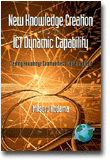
New Knowledge Creation Through ICT Dynamic Capability
Creating Knowledge Communities Using Broadband
Published 2008
The progress of broadband ICT is having a big impact on individual lifestyles and corporate activities. For corporate strategy, broadband use goes beyond improving management efficiency to contributing to enhancing customer services and developing new markets. In addition, the shape of corporate organizations and their behavior is changing along with recent changes in the business environment and development of broadband networks. It will become increasingly important for future business strategies to go beyond resources limited by business units within conventional corporate organizations to take positive initiatives with knowledge and competences outside the company as well as with the dynamic use of ICT, through such means as external strategic alliances, virtual corporations, mergers and acquisitions, and outsourcing.
This book describes that the full utilization of ICT based on fixed and mobile wireless broadband communication platforms supports managerial speed and excellence, while making it possible to formulate new business models.
Chapter 1 describes business process innovations and new e-business that activates the concepts and technology of video-based information networks (VIN) based on the leading broadband and wireless technologies of multimedia communication networks. Dynamic activities with VIN as a future network strategy support tool will enable business innovation through strengthening corporate competitiveness and enhancing customer services.
Chapter 2 considers theoretical frameworks related to "ICT dynamic capability" for companies that have employed ICT. "ICT dynamic capability" comprises the three elements of context architecture, boundaries consolidation, and ICT application capabilities, and is discussed from the viewpoint of the new knowledge creation process. The interaction among actors' dynamic use of VIN tools and the community knowledge creating cycle simultaneously enhances knowledge effectiveness and creativity.
Chapter 3 goes on to consider the decision-making process that introduced and activated VIN tools within the company, aimed at the acquisition of ICT dynamic capability, from the perspective of a strategy-making process.
Chapter 4 demonstrates community management frameworks exploiting VIN in the company through in-depth case study. The top-down approach through the innovative leadership of community leaders who comprehensively manage the business community spread within and outside the company will enable the dynamic use of ICT by community members. In Chapter 5, looking at the creation of business linking industry and academia, the author considers cases of VIN development through a bottom-up approach involving members in the strategic community, and shows analysis from the viewpoint of ICT dynamic capability created from dynamic interaction of context and knowledge with customers who have crossed the organizational boundaries among industries.
In Chapter 6, through emergent strategies for small and medium-sized companies, the book justifies new knowledge in-house after its creation from a trial-and-error process using a bottom-up approach, and the author looks at the feelings and behaviour of actors undertaking to improve in-house productivity and customer services as a strategy for the entire company.
In Chapter 7, the author takes up a case study of Sony, and looks at an example of VIN tools adoption by means of Sony’s deliberate strategy using a top-down approach. Moreover, learning from Sony’s trial & error method, the author considers the process of a successful VIN adoption from a bottom-up approach through emergent strategies centered on worksite organization.
In Chapter 8 the author considers successful case studies of VIN adoption by large companies. The author considers the processes that productively resolve internally generated friction and conflict and transform corporate culture through the use of both top-down and bottom-up approaches.
Finally, in Chapter 9, the book provides new insights derived from the case studies and theoretical and managerial implications related to new knowledge creation by ICT dynamic capability.
Bridging theory and practice and providing international scope, this book will be invaluable to academics and students with an interest in business, management, ICT, and to managers in high-tech industries.
-
Paperback978-1-59311-874-7
Web price: $45.04 (Reg. 52.99)
-
Hardcover978-1-59311-875-4
Web price: $80.74 (Reg. 94.99)
- eBook9781607529217

- EDU041000 - EDUCATION: Distance & Online Education
- EDU037000 - EDUCATION: Research
- BUS083000 - BUSINESS & ECONOMICS: Information Management
-
 (Re)Envisioning Social Studies Education Research
Current Epistemological and Methodological Expansions, Deconstructions, and Creations
(Re)Envisioning Social Studies Education Research
Current Epistemological and Methodological Expansions, Deconstructions, and Creations
-
 American Educational History Journal - Golden Anniversary Edition
Volume 50 Numbers 1 & 2
American Educational History Journal - Golden Anniversary Edition
Volume 50 Numbers 1 & 2
-
 Distance Learning
Volume 20 #3
Distance Learning
Volume 20 #3
-
 Distance Learning
Volume 20 #4
Distance Learning
Volume 20 #4
-
 Faculty Development
Achieving Change Through Action Research
Faculty Development
Achieving Change Through Action Research
-
 Qualitative Research With Diverse and Underserved Communities
Qualitative Research With Diverse and Underserved Communities
-
 Quarterly Review of Distance Education
Volume 24 #1
Quarterly Review of Distance Education
Volume 24 #1

